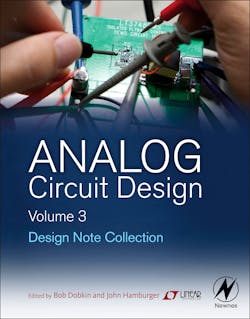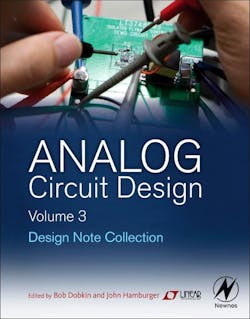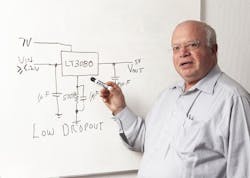Book Review: Analog Circuit Design Volume 3
Continuing Linear Technology’s popular series of DesignNotes is Volume 3 of Analog Circuit Design (opening figure) with over 1000 pages (and five pounds) of analog circuits. Edited by Bob Dobkin and John Hamburger, the book was published December 2014 by Newnes, an imprint of Elsevier.
Bob Dobkin (Fig. 2) is a founder and Chief Technical Officer of Linear Technology Corporation. He has been intimately involved in the development of high performance linear integrated circuits for over 30 years and has generated many industry standard circuits. Dobkin holds over 100 patents pertaining to linear ICs and has authored over 50 articles and papers. He says that the Design Note Collection is intended to bring new designers up to speed and give experienced designers a starting point for even more complicated designs.
Fig. 2. Founder and Chief Technical Officer of Linear Technology Corporation Bob Dobkin.
Obviously, virtually all ICs included in these Design Notes are types from Linear Technology. However, similar types are available from other sources.
In the introduction, Dobkin notes that with analog circuits the path you take to the end result affects the end result. In contrast, with digital circuits he says it doesn’t matter how you get there as long as you get the correct answer. Dobkin’s assessment of digital circuits is true for a computing application, but digital circuits are also being used to complement analog circuits where their impact is different. In fact, the Mixed Signal part of the book includes combinations of analog and digital circuits.
Reflecting on the history behind these Design Notes, John Hamburger says they were first published 25 years ago, “and after producing more than 500 notes, the genre is still going strong. Since analog design requires example and practice, Design Notes were developed to help a growing community of designers better understand design via brief notes that explain specific circuit design challenges.”
Of particular interest to power electronic engineers is Part 1 on Power Management that circuit designers will want to go over. For example, one of the design notes in Section 3 on Switching Regulator Basics is “Ultralow noise switching power supplies simplify EMI compliance.”
The 81 design notes in Section 4 cover buck switching regulator design in 162 pages. One of the design notes is “Step-down synchronous controller operates from inputs down to 2.2V.”
Next is a section on boost converter design that covers 27 design notes over 56 pages. One of these design notes is “Ultralow power boost converters require only 8.5µA of standby quiescent current.”
One of the linear regulator design notes in Section 8 is “Very low dropout (VLDO) linear regulators supply low voltage outputs.” Another note is “A simple ultralow dropout regulator.”
Battery Management in Section 12 includes 29 design notes in 60 pages that cover battery chargers, battery conditioners, and battery-powered switching regulators. One of these notes is “High efficiency lithium-ion battery charger.”
Part 2: Mixed Signal includes an Analog-to-Digital Conversion section that describes “Driving a low noise, low distortion, 18-bit, 1.6 Msps ADC.” Another note describes a “24-bit ADC measures DC to daylight.” And, there is “Micropower 12-bit ADCs shrink board space.”
The section on “Operational Amplifier Design Techniques” in Part 3 includes a design note on “Fast and accurate 80MHz amplifier draws only 2mA.” Another note is “High frequency amplifier evaluation board.” Plus, there is an “Operational amplifier selection guide for optimum noise performance.”
If your specialty is filter design, you can read Design Note 466 on page 1001, “A precision active filter block with repeatable performance to 10MHz.”
Following are the sections of the book.
Part 1: Power Management
1. Power Management Design
2. Microprocessor Power Design
3. Switching Regulator Basics
4. Switching Regulator Design: Buck (Step Down)
5. Switching Regulator Design: Boost Converters
6. Switching Regulator Design: DC/DC Converters
7. Switching Regulator Design: Buck-Boost Controllers
8. Linear Regulator Design
9. Micromodule (µModule) Power Design
10. Switching Regulators For Isolated Power Design
11. Power Control & Ideal Diode Design
12. Battery Management
13. Energy Harvesting & Solar power Circuits
14. Charge Pump DC/DC Converter Design
15. Flyback Converter Design
16. Supercapacitor Charging
17. Current Source Design
18. Hot Swap and Circuit Protection
19. Power Over Ethernet
20. System Monitoring and Control
21. Powering LED Lighting & Other Illumination Devices
22. Automotive and Industrial power Design
23. Video Design Solutions
Part 2: Mixed Signal (analog + digital)
1. Data Conversion: Analog-to-Digital
2. Data Conversion: Digital-to-Analog
3. Data Acquisition
4. Communications Interface Design
5. Instrumentation Design
Part 3: Signal Conditioning
1. Operational Amplifier Design Techniques
2. Special Function Amplifier Design
3. Voltage Reference Design
4. Filter Design
5. Comparator Design Techniques
6. System Timing Design
7. RMS to DC Conversion
Part 4: Wireless RF & Communications Design
Information on purchasing the book is available at http://store.elsevier.com/product.jsp?isbn=9780128000014&utm_source=linear&utm_medium=textlink&utm_campaign=ANACIR. The ISBN is: 978-0-12-800001-4.
About the Author

Sam Davis Blog
Editor-In-Chief - Power Electronics
Sam Davis was the editor-in-chief of Power Electronics Technology magazine and website that is now part of Electronic Design. He has 18 years experience in electronic engineering design and management, six years in public relations and 25 years as a trade press editor. He holds a BSEE from Case-Western Reserve University, and did graduate work at the same school and UCLA. Sam was the editor for PCIM, the predecessor to Power Electronics Technology, from 1984 to 2004. His engineering experience includes circuit and system design for Litton Systems, Bunker-Ramo, Rocketdyne, and Clevite Corporation.. Design tasks included analog circuits, display systems, power supplies, underwater ordnance systems, and test systems. He also served as a program manager for a Litton Systems Navy program.
Sam is the author of Computer Data Displays, a book published by Prentice-Hall in the U.S. and Japan in 1969. He is also a recipient of the Jesse Neal Award for trade press editorial excellence, and has one patent for naval ship construction that simplifies electronic system integration.


